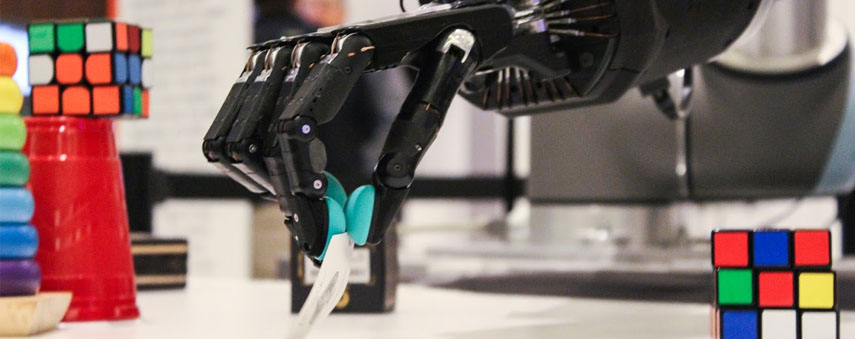Meet the incredible robot hand that could transform remote operations

Credit: Shadow Robot Company
Shadow Robot Company’s robot hand, the Tactile Telerobot, has been used to move chess pieces 5,000 miles away. Now it could be used for critical missions.
There are plenty of fears that come with the rise of robotics but none more so than a loss of control. The idea that we could relinquish our power as the dominant species on Planet Earth to the machines is one that terrifies us, whether you’re worried about your job or simply your relevance.
So whilst this is the age where we’re supposed to be outsourcing our most menial tasks to the machines, this is also the age where we try and wrestle control back from technology. Elon Musk wants to upgrade us with Neuralink. Wearable tech is set to supercharge us further. Amazon boss Jeff Bezos is intent on visits to space to see if we can set up colonies on other worlds.
Back on Earth though, there are developments that excite Bezos: in particular when it comes to robot control. Shadow Robot Company have developed the world’s first haptic telerobot hand, the only robot hand on the market to have 24 movements and 20 DOF (degrees of freedom, the number of single-axis rotational joints).
“The premise of how the technology works is relatively simple and it’s been called ‘weirdly natural’ by Jeff Bezos,” says Rich Walker, the Managing Director at the Shadow Robot Company. “An operator wearing the haptic gloves can control the robot hand even in another room or vicinity, which is why it’s particularly great for jobs that would benefit from remote operation from a safe distance. The robot hand mimics the operator’s hand and arm movements allowing the operator to guide the robot hand to handle materials and complete tasks.”
“The sensors on the robot hand relay touch sensations back to the operator wearing the glove so the operator can feel what the robot hand is touching without physically touching the object with their own hands.”
How did the robot hand come about?
“We’ve been going for 22 years: 32 years if you consider our attic-meets back in 1987 when we were a small bunch of robot enthusiasts,” says Rich, adding, “which we still are but with proper jobs now.”
Shadow Robot Company’s first creation as hobbyists was a walking, bipedal robot: the prototype of which can be seen on display at the Science Museum in London. The team focused on the hand from there on, challenging themselves to construct the five-fingered Shadow Dexterous Hand: the world’s most advanced robot hand with unprecedented dexterity.
The company won the AIconics Awards 2019 for Best Innovation in AI Hardware and the innovation became a key component in the Tactile Telerobot for advanced teleoperation and telepresence.
With touch feedback, an operator cannot only perform the task more effectively by using the robot hand as if it were their own hands but he or she can really feel present in the teleoperation site creating a more realistic and human experience.
Rich Walker, Managing Director of the Shadow Robot Company
“The Tactile Telerobot is a result of a collaboration with two other leading companies, SynTouch and HaptX, both based in the US,” says Rich. “We were brought together for a project funded and facilitated by ANA Holdings, the parent company of the Japanese airline, All Nippon Airways, which runs an initiative promoting the development of avatar technology.”
“That’s what’s great about this project and product, it explores what is possible and where its use may be more necessary than in other applications but that’s not to say it can’t be applied across all as a multi-sector tool!”
How does it work?
The Tactile Telerobot is an amalgamation of Shadow Robot Company’s highly dexterous robot hand technology with SynTouch’s biomimetic tactile sensors on the hand’s fingertips and HaptX’s realistic haptic feedback gloves to help control the robot hand whilst transmitting touch.
“The fingertips have sensors by SynTouch which contain a rigid core surrounded by an elastic liquid-filled skin (saline) to give compliance remarkably like the human fingertip,” says Rich. “The HaptX gloves have actuators lightly displacing the skin on the user’s fingertips enabling it to provide force feedback and transmit touch from the robot hand to the user wearing the glove.”
The hand mimics the operator’s arms and hand movements within the haptic gloves, giving them a realistic feel and complete control to handle materials and difficult tasks.
“The sensors on the robot hand relay touch sensations back to the operator wearing the glove so the operator can feel what the robot hand is touching without physically touching the object with their own hands,” Rich explains. “The sensors by SynTouch are capable of sensing force, vibration, and temperature which is identical to human touch capabilities. In our recent tests, a human operator in California was able to operate a computer keyboard in London, with each keystroke detected through fingertip sensors on their glove and faithfully relayed across the Atlantic to the Dexterous Hand to recreate.”
Touch is an underrated aspect of manual tasks.
“For example, some workers in the nuclear sector are using robots to handle radioactive materials without a sense of what they’re touching, which is extremely difficult and adds more risk to an already risky job,” says Rich. “With touch feedback, an operator cannot only perform the task more effectively by using the robot hand as if it were their own hands but he or she can really feel present in the teleoperation site creating a more realistic and human experience.”
What does the future hold for the hand?
The hope for this robot hand is that the technology could become used for all kinds of sensitive manual jobs that require a human touch. The Tactile Telerobot has already been used to move chess pieces from over 5,000 miles away and Shadow Robot Company have hopes of the technology being used in more serious situations.
“This type of distance is extremely useful for nuclear-decommissioning operators, disaster response teams, or companies with multiple offices who can engage with another site despite being based in another country or continent!” says Rich. “We’re already in talks with the UK nuclear establishment regarding the application of this advanced technology. It adds a layer of safety between the worker and the radiation zone as well as increasing precision and accuracy within glovebox-related tasks.
Rich also thinks that the hand could be used for the reverse too: to protect chemicals from people. In pharmaceuticals, the presence of people is a potential contaminate.
The future of this device remains exciting and the team are certain of its potential impact on the world.
“At Shadow, we know we’ve built something revolutionary,” says Rich, adding, “We are an ethical company and we don’t take on projects that compromise our values.”
The future of the Tactile Telerobot remains how it can be integrated into all kinds of practices. As more and more industries look to seize control back from the robots, Shadow Robot Company’s path looks to be a bright one. “We don’t know exactly how the journey will pan out,” Rich says, “But we look forward to being there every step of the way.”
